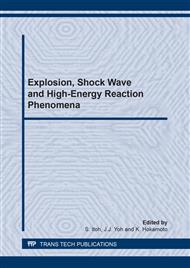p.53
p.59
p.65
p.71
p.77
p.83
p.89
p.95
p.101
Testing Techniques to Eliminate Frictional Effect and to Achieve Constant Strain-Rate in Split Hopkinson Pressure Bar Impact Compression System
Abstract:
In order to obtain the intrinsic stress – strain relationship by split Hopkinson pressure bar (SHPB) impact compression system, two testing techniques to eliminate the frictional effect and hold the prescribed constant strain-rate are demonstrated. The extrapolation method eliminating frictional effect at the tool – specimen interface was exhibited. Several specimens with different height were used for changing the initial diameter / height ratio in the method, where the circular plates were laminated. In order to maintain the constant strain-rate during compression, the incident pulse was adjusted to elevate in accordance with the compression force, where the tapered cylindrical striker bar was applied. Test material is a fully annealed pure aluminum. The intrinsic stress – strain relationship at strain-rate of 1000 /s was determined and the strain-rate sensitivity was also determined. The numerical simulation of the SHPB impact compression system was also performed using the dynamic explicit finite element method. The additional evidence for these experimental techniques to accomplish the elimination of friction and the constant strain-rate was shown.
Info:
Periodical:
Pages:
77-82
Citation:
Online since:
January 2011
Authors:
Keywords:
Price:
Сopyright:
© 2011 Trans Tech Publications Ltd. All Rights Reserved
Share:
Citation:


